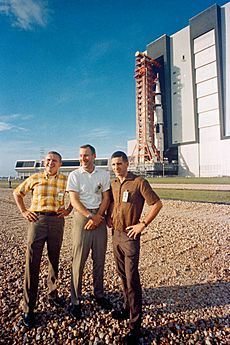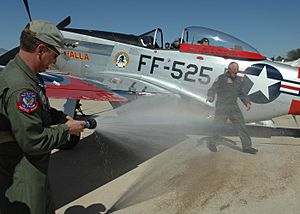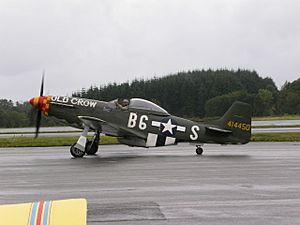William Anders facts for kids
Quick facts for kids
Bill Anders
|
|
|---|---|
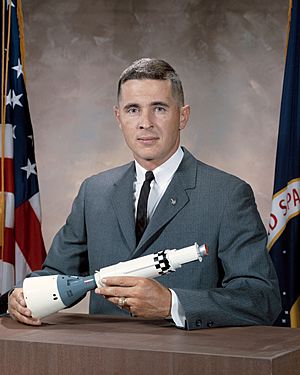
Anders in 1964
|
|
| Born |
William Alison Anders
17 October 1933 |
| Died | 7 June 2024 (aged 90) San Juan County, Washington, U.S.
|
| Awards |
|
| Space career | |
| NASA astronaut | |
| Rank | Major General, USAFR |
|
Time in space
|
6d 3h |
| Selection | NASA Group 3 (1963) |
| Missions | Apollo 8 |
|
Mission insignia
|
|
| Retirement | 1 September 1969 |
| United States Ambassador to Norway | |
| In office 11 May 1976 – 18 June 1977 |
|
| President | |
| Preceded by | Thomas Byrne |
| Succeeded by | Louis A. Lerner |
William "Bill" Alison Anders (born October 17, 1933 – died June 7, 2024) was an American NASA astronaut, electrical engineer, and nuclear engineer. He was also a United States Air Force (USAF) major general and a businessman. In December 1968, he was part of the Apollo 8 crew. This mission made history as the first time humans left low Earth orbit and traveled to the Moon.
Along with his fellow astronauts, Frank Borman and Jim Lovell, Anders orbited the Moon ten times. They sent live pictures and comments back to Earth. This included a special Christmas Eve reading from the Bible. During one of their orbits around the Moon, Anders took the famous Earthrise photograph. This picture shows Earth rising above the Moon's horizon.
Anders graduated from the United States Naval Academy in 1955. He then joined the United States Air Force (USAF). He became a fighter pilot and flew planes that carried nuclear-tipped missiles. He later earned a Master of Science degree in nuclear engineering in 1962. After his time as an astronaut, Anders worked in government and business. He served as the Ambassador to Norway from 1976 to 1977. He passed away on June 7, 2024, when his vintage plane crashed into Puget Sound.
Contents
Early Life and Childhood
William Alison Anders was born in British Hong Kong on October 17, 1933. His father, Arthur F. Anders, was a United States Navy lieutenant. His mother was Muriel Adams. The family later moved to Annapolis, Maryland. There, his father taught math at the U.S. Naval Postgraduate School.
After Annapolis, Anders' family moved to Nanjing, China. In 1937, the Second Sino-Japanese War began, and Japan invaded China. In December of that year, his father was on the river gunboat USS Panay. The ship was attacked and sunk by Japanese bombers, and his father was hurt. As Japanese forces moved toward Nanjing, Anders and his mother escaped by train to Guangzhou.
From their hotel in Guangzhou, they saw Japanese planes bombing ships on the Pearl River. This was scary because the river was their only way to escape. The river also had mines, and there was a risk of being attacked by bandits. On the boat, foreigners had to be separated from Chinese people by barbed wire. They finally reached the Philippines. There, they waited for news of his father. Arthur Anders was rescued by the British. He recovered from his injuries and an infection at a hospital in San Diego. He received the Purple Heart and the Navy Cross for his bravery.
The family returned to the United States. Anders was active in the Boy Scouts. He reached the rank of Life Scout, which is the second-highest rank. As a teenager, Anders went to Grossmont High School in El Cajon, California. To get better grades for the United States Naval Academy, he attended Boyden School. This was a military academy prep school in San Diego. He loved watching planes fly low over the school. This made him very interested in flying, and he built model aircraft. He graduated from Boyden in 1951.
Joining the Air Force
Anders was accepted into the United States Naval Academy in Annapolis, just like his father. He earned a Bachelor of Science degree in electrical engineering in 1955. During his studies, he went on cruises to experience life at sea. A trip on an aircraft carrier made him realize he did not want to be a naval aviator. There were too many dangerous accidents.
After graduating in 1955, he chose to join the United States Air Force (USAF) as a second lieutenant. While at Annapolis, he met Valerie Elizabeth Hoard. They got married soon after he graduated. They had six children: Alan (born 1957), Glen (born 1958), Gayle (born 1960), Gregory (born 1962), Eric (born 1964), and Diana (born 1972).
After graduation, Anders started flight training. He flew different planes, including the jet Lockheed T-33 Shooting Star. In 1956, he earned his pilot wings. He became a fighter pilot with the 84th Fighter-Interceptor Squadron in California. He flew Northrop F-89 Scorpions, which were equipped with MB-1 missiles that carried nuclear warheads. He then served in Iceland, where he helped stop Soviet bombers from entering American airspace. He later returned to California and flew the McDonnell F-101 Voodoo.
Anders wanted to become a test pilot. He was advised to get an advanced degree first. He applied to the Air Force Institute of Technology (AFIT) in Ohio. He hoped to study aeronautical engineering. However, because of a program called Aircraft Nuclear Propulsion, he had to study nuclear engineering instead. He also took an aeronautical engineering course at Ohio State University. He earned his Master of Science degree in nuclear engineering in 1962. After this, he worked at the Air Force Weapons Laboratory in New Mexico. There, he managed programs related to nuclear power reactors for the USAF.
Becoming a NASA Astronaut
Anders applied for test pilot training. But on June 5, 1963, National Aeronautics and Space Administration (NASA) announced it was looking for new astronauts. They needed ten to fifteen people for Project Gemini and Project Apollo. Anders decided to apply for this too. In the past, only test pilots could become astronauts. This time, it was preferred but not required, so Anders was eligible.
He was one of 34 finalists chosen for interviews. On his birthday, October 17, 1963, he was told he was accepted. He became a member of the third group of NASA astronauts.
While at NASA, Anders worked on understanding radiation effects and environmental controls in space. In September 1966, he was the backup pilot for the Gemini 11 mission. Neil Armstrong was the backup commander. This would have put Anders in line for a future Gemini mission, but the Gemini program ended. Anders and Armstrong then became the first astronauts to fly the Lunar Landing Training Vehicle. This machine helped astronauts practice landing on the Moon.
Astronauts in Anders' group who didn't have test pilot training were assigned as the lunar module pilot (LMP). This was the lowest-ranking crew position for Apollo missions.
The Apollo 8 Mission
On December 22, 1966, Anders was assigned to the third Apollo mission. Frank Borman was the commander, and Michael Collins was the command module pilot (CMP). Neil Armstrong, Jim Lovell, and Buzz Aldrin were their backup crew. In July 1968, Lovell replaced Collins, who needed surgery.
The mission, planned for December 1968, was supposed to test the lunar module (LM) in Earth orbit. However, the LM was delayed and had many problems. It would not be ready to fly in 1968. Also, there were reports that the Soviet Union was planning to send a crew around the Moon before the end of the year.
Even though the LM wasn't ready, the Apollo command and service module (CSM) was. So, a CSM-only mission could be flown to the Moon. It could orbit the Moon and then return to Earth. When Borman was asked if he wanted to fly this new mission, he said "yes" right away. This mission became Apollo 8. Anders was less excited because his role as lunar module pilot meant he wouldn't have a lunar module to fly.
Borman described Anders as a serious and hardworking person. He was a great technician. Anders was always friendly and cooperative.
The Famous Earthrise Photo
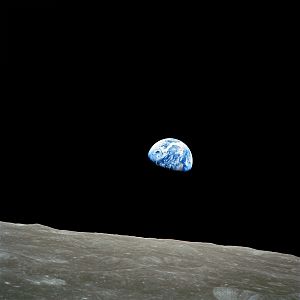
In December 1968, Anders flew on the Apollo 8 mission. This was the first time humans traveled beyond low Earth orbit. It was also the first crewed flight to reach and orbit the Moon. As the spacecraft came out from behind the Moon for its fourth pass, the crew saw an "Earthrise" for the first time in human history. NASA's Lunar Orbiter 1 had taken the first picture of an Earthrise from near the Moon in 1966.
Anders saw the Earth appearing from behind the Moon's horizon. He excitedly called to the others and took a black-and-white photo. Then, he asked Lovell for color film and took the famous Earthrise picture. Life magazine later chose it as one of its hundred photos of the century.
Anders said that seeing the Earthrise photo changed his views. He realized how small and fragile Earth is. He said, "We came all this way to explore the Moon, and the most important thing is that we discovered the Earth." He also described Earth from space as a "fragile Christmas-tree ball which we should handle with considerable care."
The Apollo 8 command module landed in the Pacific Ocean on December 27. The flight lasted over six days. It landed very close to the recovery ship, the aircraft carrier USS Yorktown.
Apollo 11 Backup Crew
The Apollo 11 mission was commanded by Armstrong. Collins was the CMP, and Aldrin was the LMP. The Apollo 8 crew became their backup crew, but without Borman. Lovell became the backup commander, and Anders became the backup CMP. Fred Haise was the backup LMP.
Life After NASA
Government Service
Anders realized that the Apollo program was ending. He felt his chances of commanding a Moon mission were small. On May 16, 1969, President Richard Nixon asked him to become the executive secretary of the National Aeronautics and Space Council (NASC). This was the highest government job offered to an astronaut at that time. Anders took the position in August.
In his new role, Anders helped create policies for space and aviation. He worked with other government offices. He tried to connect NASA with other parts of the government. He became less hopeful about the future of the space program. He did not support the development of the Space Shuttle. Instead, he thought NASA should focus on the Skylab space station. He believed a smaller Space Shuttle would be better. However, a larger one was approved because it would create more jobs in California. Feeling that the NASC did not have enough power, he suggested it be closed in 1972. It was closed on June 30, 1973.
President Nixon was impressed with Anders and wanted him to stay in the government. On August 6, 1973, Nixon appointed Anders to the five-member Atomic Energy Commission (AEC). Nixon wanted an engineer on the commission. Anders became the lead commissioner for nuclear and non-nuclear power research and development. He also worked with the Soviet Union on nuclear power technology. He spent much of his time dealing with problems in the AEC's research programs.
The AEC had a problem: it both developed nuclear energy and regulated it. People felt there was a conflict of interest. On January 19, 1975, the commission was split into two parts. The Energy Research and Development Administration (ERDA) took over research and development. The Nuclear Regulatory Commission (NRC) took over regulation. President Gerald Ford appointed Anders as the first chairman of the NRC. Anders made the NRC's decisions more open to the public. The NRC was responsible for nuclear safety and environmental issues. Unlike the AEC, the NRC had its own safety research team.
After his term as NRC chairman, Anders was asked if he wanted to be an ambassador. He asked his wife, Valerie, who was interested in Norway. Anders was appointed Ambassador to Norway on April 13, 1976. He held that job until June 18, 1977.
Working in Private Companies
In September 1977, Anders joined General Electric (GE). He became the vice president and general manager of its Nuclear Products Division. He was in charge of fuel, equipment, and tools for GE's boiling-water reactors. He also oversaw GE's partnership with another company that made large steel pressure vessels. In August 1979, GE sent him to Harvard Business School for a special program. On January 1, 1980, he became the general manager of the GE Aircraft Equipment Division. This division made many products, including aircraft flight systems, cockpit instruments, and radars.
In 1984, Anders left GE to join Textron. He became the executive vice president for aerospace. Two years later, he became senior executive vice president for operations. A benefit of this job was flying Bell helicopters, as Bell was part of Textron. During his time in government, Anders remained in the Air Force Reserve. He kept his active flight status, flying NASA Northrop T-38 Talon aircraft and helicopters. He retired from the reserves as a major general in 1988. He also advised the US government on science and technology.
Anders became vice chairman of General Dynamics in 1990. On January 1, 1991, he became its chairman and CEO. As chairman, he helped test the General Dynamics F-16 Fighting Falcon. He moved the company's main office closer to its military customers. He also sold off many parts of the company, including its missile systems and the military aircraft division. This reduced the number of employees and the company's debt. The value of the company's shares quadrupled. Anders retired as CEO in 1993 and as chairman in May 1994.
Retirement and Passing
In retirement, Anders bought a house in Anacortes, Washington. It overlooked Puget Sound. He later bought a second home in Point Loma, California, because he didn't like the winters in Washington.
Anders started the William A. Anders Foundation. This group helps with education and environmental issues. He also founded the Heritage Flight Museum in 1996 in Bellingham, Washington. The museum later moved to Skagit Regional Airport in 2014. The Anders family runs the museum. Anders was the president until 2008.
Anders passed away on June 7, 2024, at the age of 90. He died in a plane crash between Jones Island and Orcas Island. Witnesses saw his plane dive into a channel and then sink after catching fire. His son, Greg, confirmed that his father was flying a T-34 aircraft owned by the Heritage Flight Museum. At the time of his death, Anders had flown over 8,000 hours.
Awards and Honors
Bill Anders received many awards and honors for his service and achievements:
- Air Force Distinguished Service Medal
- Air Force Commendation Medal
- NASA Distinguished Service Medal
- Nuclear Regulatory Commission Distinguished Service Medal
- National Geographic Society's Hubbard Medal for Exploration
- Collier, Harmon, Dr. Robert H. Goddard and General Thomas D. White USAF Trophies
- Golden Plate Award of the American Academy of Achievement (1969)
- American Astronautical Society's Flight Achievement Award
- American Defense Preparedness Association's Industry Leadership Award (May 1993)
- In October 2018, a crater on the Moon was named "Anders' Earthrise" by the International Astronomical Union.
- Along with his Apollo 8 crewmates, Anders received AIAA's Haley Astronautics Award in 1970.
- In March 2023, Bill Anders received the 2023 Michael Collins Trophy for Lifetime Achievement from the Smithsonian National Air and Space Museum.
Anders was inducted into several halls of fame:
- International Space Hall of Fame in 1983
- International Air & Space Hall of Fame in 1990
- United States Astronaut Hall of Fame in 1997
- National Aviation Hall of Fame in 2004
He was also a member of several important engineering and aviation societies.
Images for kids
See also
 In Spanish: William Anders para niños
In Spanish: William Anders para niños


